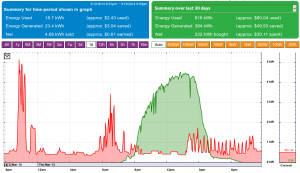Today was the perfect day for generating electricity from solar. Sure, it was blustery and cold but from a solar point of view you couldn’t ask for better conditions. The sun this time of year is hitting the panels at a sweet-spot angle, skies were absolutely cloudless, and the humidity was a low 22%. Thanks to these near-perfect conditions our solar PV system generated a whopping 23.4 kWh of electricity. In almost a year of having our panels I’ve never seen a higher total.
These absolutely clear days coupled with the fact that we haven’t had to run our air conditioner yet means that it’s more likely this time of year that we’ll bank more electricity than we use. The rest of the year we’ll cover 30-50% of our demand, so in essence our solar PV advantage will never be greater than right now.
So, with today being a rare day we can actually sell power back to Duke Energy through our net metering arrangement, just how much did Duke hand over for the 4.68 kWh of power we sold them? A grand total of 61 cents.
That’s right, sixty-one measly cents.
Now, Duke is worried about net metering…
“I think it’s time to take a look at it before it becomes a huge issue in North Carolina,” said Paul Newton, Duke’s president of North Carolina utility operations.
… so let’s do a little math. Let’s say our 4.8 kW system is a typical size (I’m too lazy to pull the actual numbers now but they’re available on the NCUC website). We know from the NCUC that there are 1,300 PV owners in the state participating in net metering (these are the small installs – not the huge solar farms, which have their own deals). If all of them were lucky enough to have the same perfect conditions as we did, today’s net metering cost Duke … wait for it … $793. Yes, just $793. Any Duke lobbyist worth her salt racks up more than that in meal reimbursements.
If an extra $793 a day spells Duke’s financial ruin then the company’s executive staff needs to be locked up for securities fraud. It’s completely ludicrous, and anyone with a solar PV system knows it. Oh, and keep in mind that in most cases Duke will never have to pony up for this $793 as many installations never generate 100% of their needs all of the time. Duke will likely never have to cut me a check for my power; unless we can always make more than our demand they make it back eventually.
Duke’s real fear is not net metering – that’s peanuts; it’s the demand that solar replaces. Solar is taking a bite (albeit small, for now) out of Duke Energy’s profits. Today we avoided buying $3.04 worth of power, a decent amount in the scheme of things. Regardless of whether or not Duke buys our power through net metering, though, we still had 23.4 kWh of power that we didn’t have to buy from Duke Energy.
This scares the pants off of any electric utility grown fat and lazy on coal. Duke might try to tarnish solar’s shine by working against net metering but will be fighting a losing battle. Imagine the solar farm Duke could build for the $1 billion it will cost just to clean up Duke’s leaky coal ash ponds, a farm that’s quiet with fixed costs and with zero pollution. Is this anything but a no-brainer?
Duke can either get on the solar train or find its customers have left the station without them. Solar puts the power in the hands of consumers and Duke’s customers are starting to get wise.
Update 3/14: I found a list of North Carolina solar PV systems [PDF] that are using Duke Energy Progress’s SunSense REPS credits. The average capacity of these 503 solar installations is 5.28 kWh.

